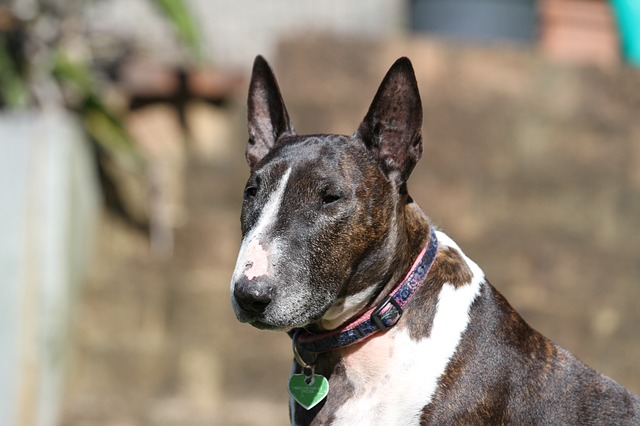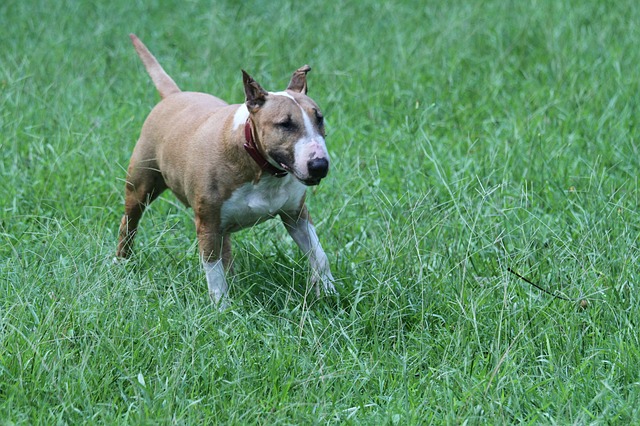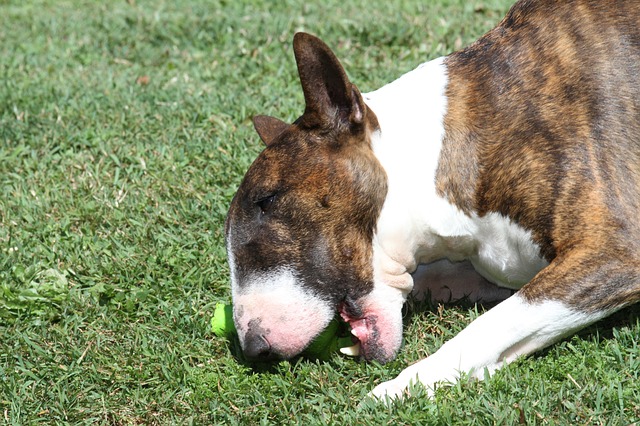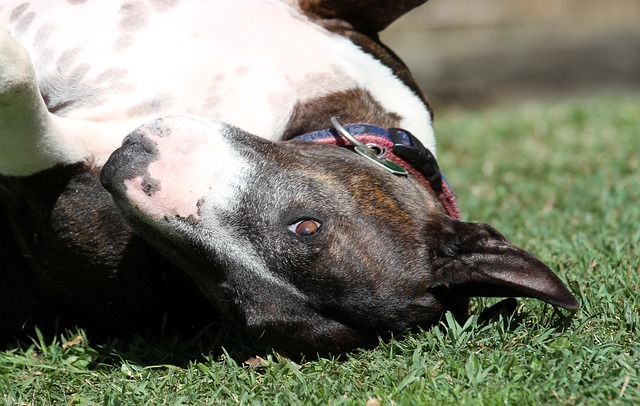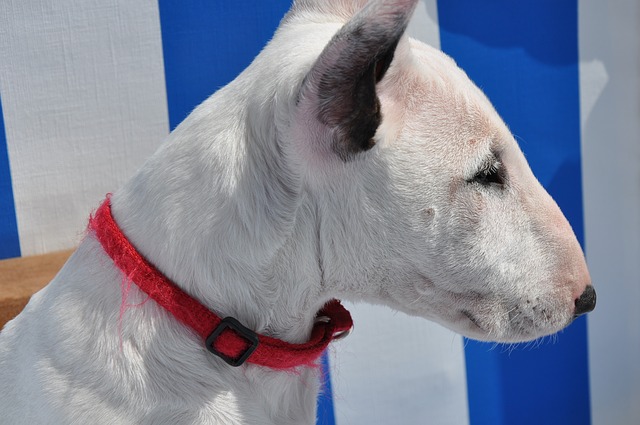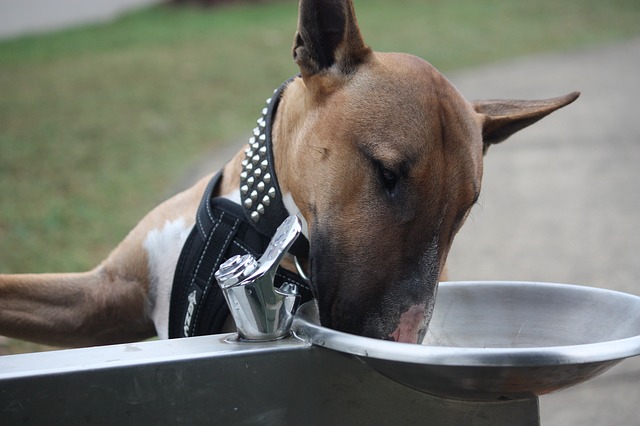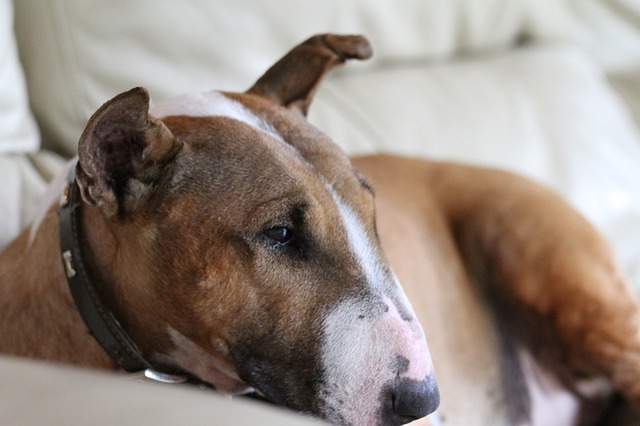Bull Terrier, also known as English Bull Terrier, The White Cavalier, Bully, Gladiator, Wedge Head and The Gentleman’s Companion, is a breed belonging to the terrier family. A miniature or smaller version of the breed is called Miniature Bull Terrier. The bull terrier is a friendly dog but it is not very eager to please. It can be stubborn at times but it is almost always upbeat. A bull terrier is an energetic dog and can be quite playful.
Origin and History
The original bull terrier is a British breed. At the beginning of the nineteenth century, the bull breed and terrier breed of dogs were popular in blood sports. They were also helpful in vermin control. Both these breeds were developed from the Old English Bulldog and Terriers. The former is now extinct. The purebred Old English Terriers are also rarely found today.
The bull terrier breed was a result of interbreeding between bulldog and terrier along with other breeds in the terrier family. The resulting breed of bull terrier was as dexterous and fast as terriers but also as stern as the bulldog. The new breed became popular for its fighting ability, inherited from the bulldog, and its spiritedness or independence inherited from the terriers. The breed became expensive in time but the original interbred variety is no longer bred or found in England or in the United States.
The breed of bull terrier you would see around has been further developed, as a result of subsequent breeding. For instance, cross breeding bull and terrier with Dalmatian lead to the white bull terrier. Today, you would find bull terriers with distinctly colorful appearances. The pure white bull terrier is still popular, so are the smaller versions.
Appearance
A male bull terrier weighs around 55 to 65 pounds whereas a female weighs around 45 to 55 pounds. Both male and female bull terriers are 18 inches to 22 inches in height. They usually have a dense short coat. The most common colors are brindle and white but you will also find red, fawn, black and red smut. A tricolor variant with a mix of red, white and black is also found.
Bull terriers usually have a muscular structure with triangular eyes. They have a robust form with an egg shaped head. The profile of its head is the most characteristic feature. The skull is flat at the top but it looks like an egg when you see a bull terrier from the front and the head kind of curves downwards to its nose. Bull terriers have properly developed nostrils. They have a strong and deep under jaw. Their eyes are small, deep set and dark, despite the distinct triangular shape. No other breed of dog is known to have such eyes. Bull terriers have a roundish body and it carries the tail horizontally.
The Bull Terrier Temperament
Bull terriers are sociable but they need to be amidst people from a very young age. As it grows older, it becomes a tad stubborn and more independent. It is quite hard to train an adult bull terrier. The breed is not ideal for people who have no experience with dogs or with training dogs. A bull terrier has a relatively even and calm temperament. It will oblige and pay heed to you but this should set in before the dog becomes stubborn. Bull terriers are a courageous breed. They are spirited and they love to have fun. Confining this breed to the four walls of a room or any stringent limitation will be unwise. Bull terriers love kids and they can blend in perfectly with a family, regardless of the number of people in the house. Studies have shown that a bull terrier has no substantial difference from the temperament of a golden retriever.
Grooming
Bull terriers need good quality dog food. This can be homemade or manufactured. It is best to check with a veterinarian before choosing a particular brand of food. The chosen diet should be suitable for the dog given its age and daily routine. The dog needs foods rich in calcium but the mineral content should be natural and not infused or artificial. Bull terriers can put on weight. Limiting the servings and encouraging day-to-day activity can resolve this concern. This dog needs fresh water. Not all human foods are good for this breed. Check with your vet.
The dog has short, harsh, glossy and flat coat. This does not require any daunting maintenance. Use a soft bristle brush or glove once a week and you can get rid of dirt, loose hair and other stuffs off the dog. Pay attention to the ears and nails. They are vulnerable to ear infections and overgrown nails can impair their ability to walk or run.
Working Roles
Bull terriers are sporty, great companions, strong and agile, spirited and protective. They can be an ideal family member, a companion of everyone in the family, a sports dog and even a watchdog. Over the years, bull terriers have been used on farms, in dog sports including flyball, agility, freestyle, carting and weight pull, in bomb detection squads and search & rescue, assistance, therapy and health alert. With the right training, a bull terrier can cater to or specialize in multiple working roles.
Health
More than one in every five pure white dogs of this breed is diagnosed with some degree of deafness. This drops down to less than two in a hundred for colored variants. You should get your bull terrier puppy checked to be sure that it is not deaf. The breed is vulnerable to allergies, mostly of the skin and resulting from insect bites, mites, mosquitoes and fleas. They can suffer from rash, itching and hives. Bull terriers usually live for ten to fifteen years. Bull terriers are particularly vulnerable to the following health concerns.
- Deafness, Complete or Partial Loss of Hearing
- Cardiovascular Problems or Heart Diseases
- Kidney Ailments including Urine and Bladder Problems
- Patellar Luxation


